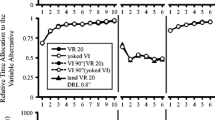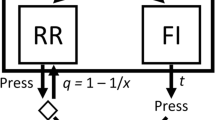Abstract
Various procedures used to evaluate preference between fixed- and variable-ratio schedules (Fr, Vr) of reinforcement have often yielded differing results with respect to the extent to which subjects will choose a Vr over an equal valued Fr schedule. A discrete-trial choice procedure, therefore, was employed in the present study in an attempt to derive a more sensitive measure of the Fr equivalent of various Vr schedules. Twelve rats were presented with choice trials consisting of various ratio values which were systematically varied across sessions according to the psychophysical method of limits. In all, the Fr equivalency measures obtained for the various Vr schedules were lower than the Vr value, demonstrating that given equal valued Vr and Fr schedules, the subjects preferred the Vr. The preference measures did vary as a function of intertriai interval (Iti) length, although the results were inconclusive. Initial response latencies (Irls) for the choice responses coincided well with overall preference measures, suggesting that they, too, could be used as a measure of preference. Also, Iti response measures were used to adjust the choice measures, indicating that such response biases as position preferences could be effectively corrected for within this type of procedure. In conclusion, the discrete-trial choice procedure as employed in psychophysics methodology holds promise for evolving a comprehensive means of evaluating operant choice.
Similar content being viewed by others
References
BAUM, W. M. (1974). On two types of deviation from the matching law: Bias and undermatching. Journal of the Experimental Analysis of Behavior, 22, 231–242.
BLOUGH, D., & BLOUGH, P. (1977). Animal psychophysics. In W. K. HONIG & J. E. R. STADDON (Eds.), Handbook of operant behavior (pp. 514–539). Englewood Cliffs, NJ: Prentice-Hall.
CAMPBELL, B. A. (1955). The fractional reduction in noxious stimulation required to produce“just noticeable” learning. Journal of Comparative and Physiological Psychology, 48, 141–148.
CATANIA, A. C., & REYNOLDS, G. S. (1968). A quantitative analysis of the responding maintained by interval schedules of reinforcement. Journal of the Experimental Analysis of Behavior, 11, 327–383.
FANTINO, E. (1967). Preference for mixed-versus fixed-ratio schedules. Journal of the Experimental Analysis of Behavior, 10, 35–43.
FANTINO, E. (1969). Conditioned reinforcement, choice, and the psychological distance to reward. In D. P. HENDRY (Ed.), Conditioned reinforcement. Homewood, IL: Dorsey Press.
FANTINO, E. (1977). Conditioned reinforcement: Choice and information. In W. K. Honig & J. E. R. Staddon (Eds.), Handbook of operant behavior (pp. 313–339). Englewood Cliffs, NJ: Prentice-Hall.
FELTON, M., & LYON, D. O. (1966). The post-reinforcement pause. Journal of the Experimental Analysis of Behavior, 9, 131–134.
GESCHEIDER, G. A. (1976). Psychophysics: Method and theory. Hillsdale, NJ: Lawrence Erlbaum.
HERRNSTEIN, R. J., & LOVELAND, D. H. (1975). Maximizing and matching on concurrent ratio schedules. Journal of the Experimental Analysis of Behavior, 24, 107–116.
HENDRY, D. P. (1969). Reinforcing value of information: Fixed-ratio schedules. In D. P. Hendry (Ed.), Conditioned reinforcement. Homewood, IL: Dorsey Pre
JACKSON, W. J., & PEGRAM, G. V. (1970). Acquisition, transfer, and retention of matching by rhesus monkeys. Psychological Reports, 27, 839–846.
JARRARD, L., & MORSE, S. (1970). Short term memory in the monkey. Unpublished Department of Psychology report, Carnegie-Mellon University, Pittsburgh, PA.
JOHANSON, C. E. (1971). Choice of cocaine by rhesus monkeys as a function of dosage. Proceedings of the 79th Annual Convention of the American Psychological Association, 6, 751–752.
JOHANSON, C. E. (1976). Pharmacological and environmental variables affecting drug preferences in rhesus monkeys. Pharmacological Review, 27, 343–355.
JOHANSON, C. E., & SCHUSTER, C. R. (1975). A choice procedure for drug reinforcers: Cocaine and methylphenidate in the rhesus monkey. Journal of Pharmacology and Experimental Therapeutics, 193, 676–688.
LEA, S. E. G. (1976). Titration of schedule parameters by pigeons. Journal of the Experimental Analysis of Behavior, 25, 43–54.
MAIER, N. R. F. (1949). Frustration. Ann Arbor: University of Michigan Press.
MENTZER, T. L. (1966). Comparison of three methods for obtaining psychophysical thresholds from the pigeon. Journal of Comparative and Physiological Psychology, 61, 96–101.
MINTZ, D. E., MAURER, D. J., & GOFSEYEFF, M. (1967). Sequential effects in fixed-ratio post-reinforcment pause duration. Psychonomic Science, 9, 387–388.
NAVARICK, D. J., & FANTINO, E. (1972). Transitivity as a property of choice. Journal of the Experimental Analysis of Behavior, 18, 389–401.
PAVLOV, I. P. (1927). Conditioned reflexes (G. B. ANREP, Trans.). London: Oxford University Press.
POWELL, R. W. (1970). The effect of punishment shock intensity upon responding under multiple schedules. Journal of the Experimental Analysis of Behavior, 14, 201–211.
REPP, A. C., & AEITZ, S. M. (1975). A comparison of fixed-ratio and variable ratio token-production schedules with human subjects. The Psychological Record, 25, 131–137.
RIDER, D. P. (1979). Concurrent ratio schedules: Fixed vs variable response requirements. Journal of the Experimental Analysis of Behavior, 31, 225–237.
RIDER, D. P. (1983). Choice for aperiodic versus periodic ratio schedules: A comparison of concurrent and concurrent-chain procedures. Journal of the Experimental Analysis of Behavior, 40, 225–237.
SHERMAN, J. A., & THOMAS J. R. (1968). Some factors controlling preference between fixed-ratio and variable-ratio schedules of reinforcement. Journal of the Experimental Analysis of Behavior, 11, 689–702.
SILBERBERG, A., HAMILTON, B., ZIRIAX, J., & CASEY, J. (1978). The structure of choice. Journal of Experimental Psychology: Animal Behavior Processes, 4, 368–398.
SNAPPER, A. G., & INGLIS, G. B. (1978). The Sked Software System: SuperSKED. Kalamazoo, Mi: The Sked Users Group.
STEPHENS, K. R. (1980). Preference reversal: Effects of ratio and reinforcement parameters. Unpublished doctoral dissertation, Western Michigan University, Kalamazoo, MI.
TARPY, R. M. (1969a). Reinforcement differences limen for effort. Canadian Journal of Psychology, 23, 410–414.
TARPY, R. M. (1969b). Reinforcement difference limen (Rdl) for delay in shock escape. Journal of Experimental Psychology, 79, 116–121.
WEINER, H. (1966). Preference and switching under ratio consequences with humans. Psychological Reports, 18, 239–246.
Author information
Authors and Affiliations
Additional information
This study was completed by Michael J. Boivin in partial fulfillment of the doctoral degree at Western Michigan University. The authors would like to thank Drs. Jack Michael and David Lyon for their comments and helpful suggestions during the course of this study. Betty Videto, Pamela England, and Jody Miller devoted a great deal of time and effort towards the preparation of this manuscript, and their efforts are greatly appreciated. The authors would also like to thank Dr. Robert Cobez and Tom Pritzel for their assistance in maintaining the apparatus during the study.
Rights and permissions
About this article
Cite this article
Boivin, M.J., Snapper, A.G. A Discrete-Trial Choice Procedure for Assessing the Periodic Equivalent of an Aperiodic Ratio Schedule. Psychol Rec 36, 257–283 (1986). https://doi.org/10.1007/BF03394945
Published:
Issue Date:
DOI: https://doi.org/10.1007/BF03394945




